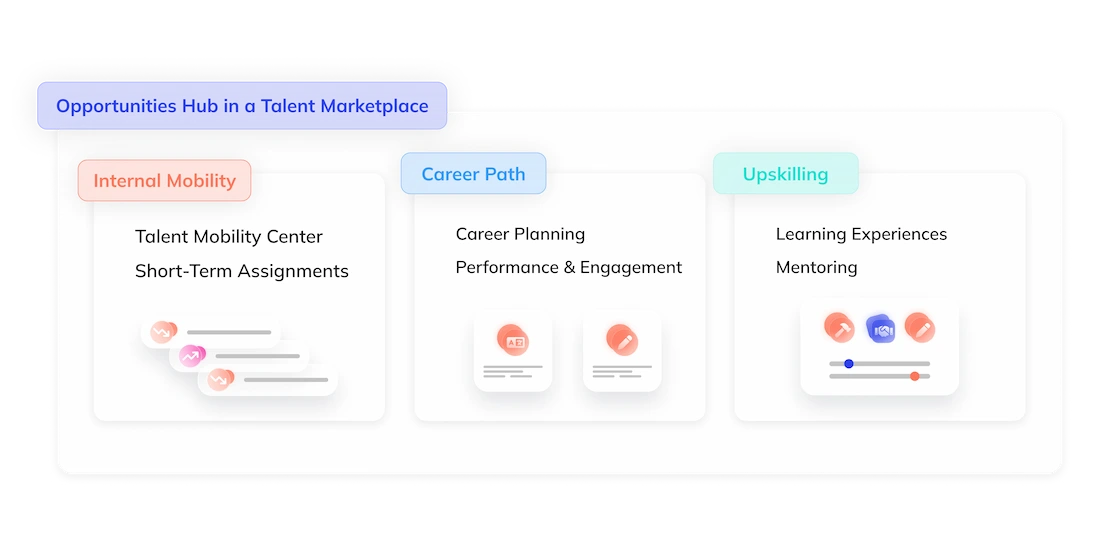The HR function's life cycle is marked by various milestones, which provide an opportunity to analyze the company's situation and adapt its strategy.
Why make the Careers Committee a highlight of the HR year?
The Career Committee or "People Review" initiates a large part of the year's HR actions : from the design of the HR development plan to the setting of the recruitment budget, including salary increases and internal mobility.
A natural extension of the annual interviews, the Careers Committee consists of bringing together managers and HR players in order to put the company's strategy into practice.
How tomake it one of the highlights of the year?
Anticipating critical departures
The proximity of managers to their employees is essential, but it is not always enough to anticipate employee attrition.
The Careers Committee, contrary to what is commonly thought, is not only about talent, but about all employees.
Thus three decisions are taken following this meeting:
- discussions with underperformers
- training of employees
- Customized support for high potentials.
One of the first exchanges is about the potential disengagement of a part of the population.
Some data and behaviors are potential warning signs:
- Net Promoter Scores results and comments
- The rarity of exchanges with colleagues and their managers
- Lack of future-oriented thinking, especially during annual reviews
If you do not necessarily have this data available, we recommend that you design the collection tools for the current year.
Matching the company strategy with the available skills
The organization can adapt to the talent shortage through two mechanisms discussed at the Career Committee:
- Effectively manage the employee development program.
This is achieved not only through traditional training (e-learning, etc.), but above all through the dissemination of a learning corporate culture that optimizes the many methods offered: collaborative learning, serious gaming, augmented reality, microlearning, etc.
- Reinforce the autonomy of employees so that they can fully express their wishes for development. All internal opportunities are grouped together in an "Opportunities Hub".
In fact, the employee can be the originator of his or her own training requests as well as the recipient of personalized suggestions. Here is an illustration of all the opportunities below to build a unique path.
The Career Committee is the ideal moment to take a step back and look at all the opportunities offered to talents. In addition, we recommend that you revisit the mapping of your skills organization from the perspective of expected levels on the one hand, and the gaps between the levels achieved on the other.
This way you will be able to identify if there are not enough skills critical to your strategy.
Identify skills at risk
At the beginning of the 90's, the lifespan of a skill was estimated at 30 years. Since then, the obsolescence of skills has affected most of the trades. This obsolescence is essentially "economic". It consists in the uselessness or the loss of importance of skills previously used in a given job.
The 3 origins of the loss of skills :
- The aging of your population. In this case, it is a structural trend in your field of activity.
- Insufficient commitment, which contributes to high turnover.
- The rapid evolution of professions which no longer guarantees the employability of the employee.
What are the consequences of this?
- Passing on knowledge internally
- Attract the skills without which your business strategy may be undermined
- Review your culture and your reason for being.
We recommend that you assess your current engagement with our free diagnostic tool.
Facilitated by the law on the professional future, companies such as Safran or Arc International have opened their own apprentice training center. Other companies like Orange or Accor have created their own internal university. This last initiative represents a significant cost, but it is an efficient way to prepare the future by capitalizing on internal knowledge.
Build project teams
The uncertainty in which organizations evolve contributes to a new form of organization in project mode. Whether they are considered strategic or not, these projects are an opportunity to focus on the skills required to complete them successfully. Once these projects have been proposed by managers and business unit heads, the role of HR is to facilitate the creation of these teams by knowing the employees, their desires and their assets.
Internal talent marketplaces are the best platforms to meet the challenges of building these teams. They facilitate internal mobility from one role to another, and are also designed to staff short-term projects. For employees, they are the best response to the need to move beyond traditional career paths that no longer meet their needs.
The internal recruitment tool that an Internal Talent Market represents is also a strong cultural change. Indeed, the manager must accept to let a resource evolve on a project that he/she no longer manages directly. This new organizational path also requires adapting the performance evaluation. Indeed, the employee is now evaluated on two dimensions: on the one hand, the core of his activity and, on the other hand, his involvement in satellite projects.
In conclusion, forming project teams during the People Review allows to mix individuals who will learn together, reinforce the adhesion to the company's projects, increase the loyalty of the employees and improve the performance.
Detecting high potentials
In a context of market changes and accelerated transformation, companies must identify the leaders of tomorrow. The Career Committee is the opportunity, if not to identify them, to set the criteria for the attribution of the "high potential" status.
What criteria should be used to detect high potentials?
- Natural adaptation to new responsibilities
- Proactivity the ability to create new things
- Stress resistance in an uncertain environment
- emotional and collective intelligence
- Taking a step back
- The ability to learn
These criteria are to be adapted according to your strategy and your business. We insist on the fact that this detection is not only reserved for current managers. Moreover, it requires a significant amount of data in order to analyze past and current behaviors (ideally, a minimum of 3 years).
If you already have a mature approach to these"High Po", the People review should consist of taking the necessary measures to ensure that these talents quickly reach their highest potential. After the career committee, we advise you to share your assessment of their potential, listen to their aspirations, and set a support plan with short iterations.
Assessing Training Benefits and Defining Future Training Sessions
Your mandatory skills development plan is an important direct investment whose impact must be measured. The law of March 5, 2014 requires the employer to evaluate its training on official documents.
The current indicators are often not sufficient since they consist, most often, of measuring the number of hours of training and the satisfaction of "learners".
Measuring the effectiveness of a training course is a complex exercise since it depends on human factors such as the employee's motivation to invest in it. We talk more about "return on expectations" than "return on investment".
How to measure training performance?
- The evolution of post-training behavior
- Obtaining certificates, the level of requirement required from training organizations is evolving in this direction
- Achieving the objectives set for this training
- Business indicators (customer satisfaction, compliance with project deadlines, etc.)
The HR function must demonstrate the effectiveness of its function, whether it be in its administrative management, adherence to the company's culture or the strategic areas of skills and training.
Boosting internal mobility
Companies are rediscovering the treasure that internal mobility represents in a context of war for talent and low retention. Not only does mobility save on recruitment costs, but it also fosters a culture of getting to know employees whose skills are not always visible. Internal mobility offers a new type of leadership with employees who have taken a step back from the company and established relationships with different individuals.
Whereas it used to be synonymous with a career plan, internal mobility is now becoming agile, driven by a strong sociological change.
A survey byOpinion Way in October 2021 showed that only 27% of 35-49 year olds wanted to become a manager. Companies that are used to having their employees evolve in several activities at the same time have a head start on this agility. For example, Natixis has managed to accelerate internal mobility to 50% for certain roles.
When reviewing your talent, your ability to avoid repeating past patterns of evolution will be key to bringing organizational innovation. Finally, you will meet the expectations of employees for whom learning is a major source of motivation.
Retain your employees and managers
Your employees demand transparency in decisions, recognition of their achievements and concrete means to develop.
The Careers Committee is thus the pillar of your employees' future loyalty. All the measures taken at the end of the committee must be immediately implemented through your HR tools.
Here is a summary of the different components of the HRIS that will be fed by the People Review:
- The integration of new trades within this mapping
- The mapping of your skills, the levels reached and the possible modifications of levels expected.
- Updating your Talent Marketplace with the distribution of strategic projects and the solicitation of employees who meet your challenges.
- Your high potential module, to which you will associate their specific coaching
- Succession planning for high-stakes positions
- The integration of new training courses in your catalog and the suggestion of training courses to the populations concerned.
Are you going to invest in this HR "highlight"?
We accompany you with the 6 keys to achieve it with brilliance!
Download our guide as an infographic 👇














